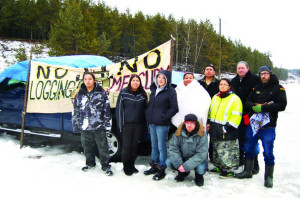Grassy Narrows lawyer explains Supreme Court argument
After the Supreme Court of Canada hears arguments from Grassy Narrows First Nation and the Province of Ontario, it will be tasked with deciding whether or not the province’s constitutional power to manage natural resources gives it the unilateral ability to harvest on treaty land even when it infringes on treaty rights.
“The Treaty 3 says (Grassy Narrows) have the right to hunt and fish except where the government of Canada takes away those rights … the fight is whether the federal government still has a role in treaty rights when they’re being interfered with. And we say (they do),” said Robert Janes, the lawyer for Grassy Narrows.
What it boils down to, said Janes, is interpretation. The text of Treaty 3 gives the power to take land for resource development, even if First Nations have hunting and fishing rights to that land, to “Her (Majesty’s) said Government of the Dominion of Canada, or by any of the subjects thereof duly authorized therefor by the said Government.”
The province believes that because the Canadian constitution gives it complete control over natural resource development, the treaty power given to take up land for development belongs to the province alone. This line of reasoning was agreed with by the Ontario Court of Appeal last spring.
Grassy Narrows’ legal team is planning to argue at the Supreme Court that since the treaty was originally negotiated with the federal government, it is the level of government the treaty’s wording refers to. They will also argue that other Supreme Court decisions have set the precedent putting provincial decisions which interfere with treaty rights inside the federal government’s jurisdiction.
Janes does not see the case as asking the Supreme Court to establish a brand new exception to the powers of provincial governments.
“This is not an new argument. The Supreme Court has said different versions of this in decisions going all the way back to confederation … in the previous cases it was about things like issuing hunting licences, in this case it’s about the government taking the land and saying ‘go hunt elsewhere,’” said Janes.
Even if the Supreme Court rules in favour of Grassy Narrows, all they will get is to have the federal government involved in the decision to allow forestry inside their traditional territory. Janes said he expects that could play out a couple ways.
The federal government could create legislation with conditions and limits on how provinces are able to infringe on treaty rights. But Grassy Narrows wants to negotiate a new, clearer arrangement for resource extraction in the region that goes beyond the 140-year-old treaty.
“Here we are in the 21st Century applying a 19th Century document. Our position has been to see the governments sit down with the Treaty 3 people and work out a modern agreement that goes along with the treaty,” said Janes.
The federal government could also simply decide to let the province go ahead with its plans for the Whiskey Jack, but Janes said he doubts that would happen since the federal government would also be obligated to consult with Grassy Narrows before making its own decision. He also argued the federal government would be more impartial than either the province or the First Nation.
“There is an intrinsic conflict of interest with the province. It gets timber revenues and solved political problems at the expense of treaty rights,” said Janes.
It could be a year and a half before the Supreme Court decides this issue one way or another. Janes said they are not expecting to get their one-day hearing in front of the justices until next summer or fall, and it often takes another six months before the court’s decision is ready to be released.





